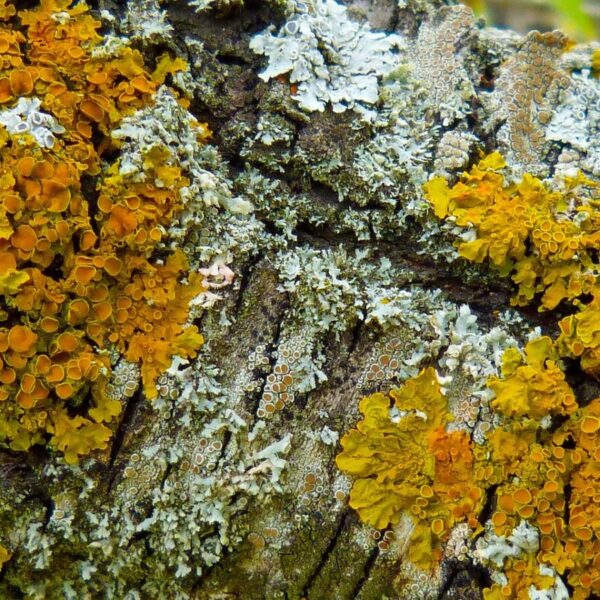Forgotten, they are making a grand return to scientific laboratories. These strange organisms, combining algae and fungi, are indeed valuable indicators of air quality. At the natural history museum in Aix-en-Provence, an exceptional collection is resurfacing, driven by the passion of researchers determined to bring them back to light.
By Agathe Perrier
To date, around 3,000 species of lichens have been identified in France, out of an estimated total of over 20,000 worldwide. Each of them interacts specifically with its environment. Some thrive in nitrogen-rich environments, while others reveal the presence of metals in the soil. Their diversity makes them a remarkably precise tool for studying air pollution.
Lichens as warning signals
They cover the bark of trees, colonize rocks, and even settle on roofs or walls. Yet, they are hardly noticed. Often confused with moss, lichens are complex organisms, explains Nathalie Séjalon-Delmas, a doctor in plant sciences: “It’s a symbiosis. A community of life between an alga and one or more fungi that provide mutual benefits.” The alga, through photosynthesis, supplies the fungus with carbon, essential for its nutrition. In return, the fungus provides its partner with water and mineral salts, while protecting it from external threats, such as atmospheric pollutants or dehydration. A balanced relationship, mutually beneficial, which makes the lichen particularly resilient,” adds the researcher, who is also a teacher-researcher at the University of Toulouse III-Paul Sabatier.
This unique symbiosis is currently experiencing a resurgence of interest among scientists, after decades of neglect. Their particularity? These discreet roommates of our landscapes have much more to offer than just their plant presence: they are excellent witnesses to the quality of the air we breathe.
A treasure brought back from oblivion
At the natural history museum in Aix-en-Provence, lichens have a very particular story. Their collection, initiated in the 1950s by Raymond Dughi, a former curator and renowned lichenologist, remained abandoned for a long time. This enthusiast had conducted a vast inventory, collecting specimens or acquiring them from other researchers. But after his retirement in 1963, the work came to a complete halt. Without a successor, the boxes remained closed... until recently.
For the past three years, Isabelle Chanaron, head of the botanical collections at the museum, has taken on a titanic task: to inventory the entire collection of lichens. A time-consuming but crucial mission. “I open the boxes, analyze the labels, sometimes illegible or outdated, and I catalog them one by one,” recounts this former pharmacist turned botanist. Over time, place names have changed, some information has disappeared, making the task even more complex. Nevertheless, she has already cataloged 37,000 labels, each of which may correspond to several specimens. The exact number of lichens in the collection remains unknown, but Isabelle estimates that there are between 70,000 and 100,000.
Although these herbaria are no longer visible to the public — the museum has been closed for a decade due to a lack of a venue — they remain invaluable for research. Indeed, lichens, once collected, retain traces of the pollutants absorbed from their original environment. These “natural archives” thus allow for comparisons of air quality at different times and in different places, some of which may have disappeared or transformed since. Researchers can thus trace the environmental history of a site by analyzing the molecules still trapped in these samples.
Bio-indicators being rediscovered
Why have these useful organisms been set aside? According to Isabelle Chanaron, lichenology is a demanding science. “It is essential to work under a microscope; it is long and complex.” A technical know-how, little valued, which has ultimately been lost. Nathalie Séjalon-Delmas agrees: “This science has always been marginal. It declined at the same time as interest in fungi.”
But the tide is turning. Because lichens are not only useful for monitoring pollution. Pharmaceutical laboratories are now closely interested in their antibacterial properties. Some molecules naturally produced by these organisms could be used to develop new antibiotics. On one condition: to succeed in cultivating lichens in the laboratory. Which, for now, remains a challenge. Indeed, their growth is extremely slow — from a few millimeters to a few centimeters per year — and some go dormant in response to environmental stress. It is safe to say that in vitro cultivation is not on the horizon.
Scientists are therefore primarily betting on their role as bio-indicators. Their presence, or their condition, indeed provides information about the pollution level of the location where they are found. “Since they do not have a filtration system, unlike plants, they absorb both water and the pollutants it contains. This can kill them,” explains Nathalie Séjalon-Delmas.
Capable of documenting comparative studies on the atmosphere
Not all are vulnerable to the same pollutants, which also provides details about the nature of those present. “When Acarospora sinopica settles on a rock, it indicates that it contains iron. Physcia adscendens and Xanthoria parietina, known to be nitrogen-loving, signal an increase in nitrogen and therefore generally indicate either an increase in road traffic or significant nitrogen fertilizer application. (…) Lichens are thus warning signals, in a way,” can be read in an article from the University of Toulouse III-Paul Sabatier. In this respect, the previously inventoried herbaria prove to be a goldmine of information. Because the pollutants sequestered by the lichens before their collection are still trapped there. This can fuel comparative studies on the past and present atmospheric pollution of a site.
Today, only a few European countries, such as Germany, Italy, Belgium, Luxembourg, and England, are truly investing in lichenological research. In France, the dynamic is slowly reviving. And there remains enormous room for progress. “There are still plenty of places in the world where no one has searched for lichens,” remarks Isabelle Chanaron. These discreet and essential beings have therefore not finished making headlines.

Featured Photo: Lichens colonize rocks, the bark of trees, roofs, or walls © Marc-Pascual - Pixabay
